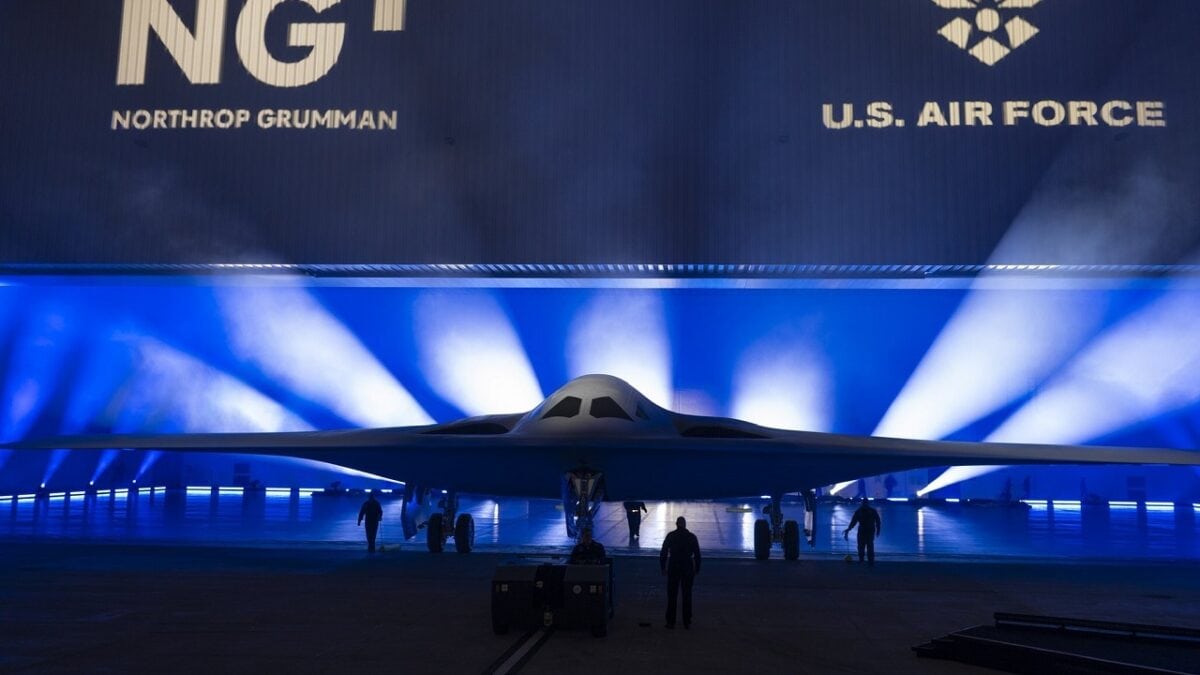Editor’s Note: This is a multi-part series looking at the B-21 Raider. You can find part I here, part II here, part III here, and part V here.
During its rollout in December, the B-21 was hailed as the U.S.’s “first strategic bomber in more than three decades.” The implication was that it is good for so many years to pass between the introduction of new bomber types — it allows lessons to be learned and applied. But there should be no rationalizing the fact that almost half a lifetime transpired before the government-industry partnership offered a new aircraft to refresh the smallest and oldest bomber fleet the country has maintained in memory.
Such drawn-out timelines have become the sad reality across the board. For example, take the incredible gap of 42 years between the commissioning of the first Nimitz-class aircraft carrier in 1975 and that of its successor, the first in the Ford-class, in 2017. Many of the engineers and craftsmen who worked to make the leap from one generation to the next were gone by the time the subsequent generation came around. The atrophying of vital skills pertaining to generational platforms causes a snowballing effect — it stretches out protracted timelines even further.
Past Platforms Serving Present Needs
This was evident when the first Ford-class ship was contracted. It took nine years to construct the USS Gerald R. Ford and another five years for it to deploy. If such timelines had prevailed during World War II, it is hard to imagine any new-class carrier being built in that time of dire need. Yet the Kaiser shipyard in Vancouver, Washington, actually produced 50 new Casablanca-class escort carriers in less than two years.
Letting 30 or 40 years lapse between generations means that industry has to figuratively reinvent the wheel each time, accentuating the risks of schedule delays and cost overruns. This glacial development cadence also risks having out-of-date systems serving present and near-future requirements.
The first B-2 was delivered to the Air Force in 1993, with the type’s initial operational capability achieved in 1997. The B-2’s follow-on was to have an in-service date of 2018, but in the early days of the Barack Obama administration, the nascent Next-Generation Bomber (NGB) was deferred due to cost concerns and the status of nuclear arms control negotiations.
That was a time marked by ballooning defense budgets aimed at fighting interminable guerrilla-style wars in Afghanistan and Iraq. Moreover, the Cold War was thought to have ended years before, leading to a de-emphasis on weapons for major-power conflicts. The NGB program was reconstituted as the Long-Range Strike Bomber program, which had a mandate to keep a lid on costs but lacked a target completion date. The B-21 evolved from this program.
A month after the B-21’s rollout, two former secretaries of the Air Force whose terms coincided with the plane’s development praised the program, suggesting it could be a model of how to minimize bureaucratic meddling. Indeed, in an unusual move, the B-21’s development was managed by the Air Force’s Rapid Capabilities Office, which cut red tape to shorten what would have been an even longer process. The B-21’s rollout came seven years after the contract award, which is considered lightning-fast by current standards. Yet even barring any future setbacks, the bomber’s initial operational capability will occur in the mid-2020s — about seven years past the originally anticipated in-service date of 2018 for the B-2’s successor, and nearly 30 years after the B-2’s operational standup.
Relearning to Rush the Mustang
Should senior Air Force officials praise such a timeline? Somehow, long before the era of digital design tools, when rooms full of draftsmen at wooden desks using protractors, T-squares, and mechanical pencils were at the center of the design process, development timelines were often remarkably shorter.
The birth of North American Aviation’s P-51 Mustang is a prime example. In a rush for superior combat aircraft, the British approved a letter of intent for a brand-new fighter from North American Aviation on April 10, 1940. A mere six months later, on Oct. 26, the prototype took to the sky. Incorporating various innovative features like a laminar-flow wing and a low-drag engine cooling system, the rapidly delivered prototype was the basis for what was arguably the best all-around fighter of World War II. Over the next five years, NAA produced more than 15,000 Mustangs, mostly for the U.S. Army Air Forces, improving the design of early models to arrive at the definitive variant — the P-51D.
On the other side of the development equation, Defense Secretary Lloyd Austin stated at the B-21’s rollout that the new bomber’s “edge will last for decades to come.” But is that realistic in a world with renewed major-power competition and emboldened rogue states? Shouldn’t it be obvious that peer competitors like China and outright adversaries like Iran are not operating on similarly yawning schedules?
Because technology is advancing at breakneck speeds, the unforeseen can happen in the long gaps between new classes of weapons. Already in the skies over Nagorno-Karabakh and Ukraine, Turkish and Iranian drones have shown the damage that can be done by swarms of new and inexpensive uncrewed aircraft, and how hard it can be to defend against such systems. Even more worrying, some military analysts forecast that it will not be long before fully autonomous drones — the dreaded killer-bots of science fiction — become common battlefield weapons. This is thanks to advances in artificial intelligence and machine learning, some of the very technologies that are integral to the success of the B-21 and its family of systems.
The Need for Speed
We should also remember that stealth platforms, for all their advantages, are not invincible. An F-117 Nighthawk, the first true all-aspect stealth combat plane, was downed by a Yugoslav version of the Soviet SA-3 surface-to-air missile system in 1999 during Operation Allied Force. Anti-stealth techniques have advanced in the years since, and there is concern that breakthroughs in high speed real-time signal processing could cause even the latest iteration of low-observable aircraft to fall prey to air defenses.
If so, designers might need to pivot quickly from using stealth as the design catch-all to prioritizing instead the old design drivers of speed and altitude. This is another reason to spur the development of hypersonics (objects that fly in excess of Mach-5, or five times the speed of sound).
Secretary of the Air Force Frank Kendall, a former Raytheon executive with a Master of Science degree in aerospace engineering from CalTech, remarked in September 2021 on the need to reverse the lack of progress in flight-testing hypersonic platforms. He also expressed concern over the lack of a concept of operations. But during a virtual “fireside chat” hosted by the Center for a New American Security on Jan. 19, 2022, Kendall questioned the prior administration’s sprint to develop hypersonic weapons, and he voiced doubt about their cost-effectiveness.
Despite the mixed signals, there appears to be growing recognition by Secretary Kendall and others in the defense establishment that the U.S. fell behind China and Russia in hypersonics, and needs a concerted push to catch up. From the late 1950s through 1967, the U.S. blazed an extraordinary trail in hypersonics with the winged and piloted X-15 rocketplane, which set altitude and speed records of 354,200 feet and Mach 6.7. While the current hypersonic focus is on newer concepts such as boost-glide and airbreathing scramjet technologies, which offer enhanced maneuverability and endurance, the point is that the U.S. had a crewed and steerable endo/exo-atmospheric hypersonic vehicle over 60 years ago.

B-21 Raider. Image Credit: U.S. Air Force.
Among the various hypersonics programs currently underway to address the slippage, Project Mayhem is an Air Force Research Laboratory (AFRL) initiative to develop a large, long-range airbreathing hypersonic platform. In December 2022, the AFRL contracted for a technical data package to eventually enable the production of prototypes. An airbreathing hypersonic bomber incorporating the B-21’s technologies might emerge from this effort in the years to come.
Once a combined-cycle propulsion system and other enabling technologies are within reach, it is to be hoped that the U.S. development timeline for this type of hypersonic aircraft will reflect the necessary urgency. Whoever gets there first will be empowered to trumpet the crossing of another threshold – into the seventh generation.
Author Expertise and Experience
Philip Handleman is a pilot and aviation author/photographer. With retired Air Force Lt. Col. Harry T. Stewart, Jr., he cowrote Soaring to Glory: A Tuskegee Airman’s Firsthand Account of World War II. Mr. Handleman’s photograph of the Air Force Thunderbirds was featured on the postage stamp honoring the 50th anniversary of the Department of the Air Force in 1997.

